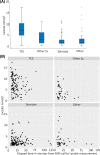Prehospital lactate levels in blood as a seizure biomarker: A multi-center observational study
- PMID: 33417237
- PMCID: PMC7898511
- DOI: 10.1111/epi.16806
Prehospital lactate levels in blood as a seizure biomarker: A multi-center observational study
Abstract
Objective: The objective of this study was to assess the value of prehospital measurement of lactate level in blood for diagnosis of seizures in cases of transient loss of consciousness.
Methods: Between March 2018 and September 2019, prehospital lactate was measured with a point-of-care device by the emergency medical services in an area serving a population of 900 000. A total of 383 cases of transient loss of consciousness were identified and categorized as tonic-clonic seizure (TCS), other seizure, syncope, or other cause, according to the final diagnosis in the electronic medical records system. Receiver operating characteristic curve analyses were used to identify the optimal lactate cut-off.
Results: A total of 383 cases were included (135 TCS, 42 other seizure, 163 syncope, and 43 other causes). The median lactate level in TCS was 7.0 mmol/L, compared to a median of 2.0 mmol/L in all other cases (P < .001). The area under the curve (AUC) of TCS vs nonepileptic causes was 0.87 (95% confidence interval [CI] 0.83-0.91). The optimal cut-off (Youden index, 67.8%) was 4.75 mmol/L, with 79% sensitivity (95% CI 71-85) and 89% specificity (95% CI 85-93) for TCS.
Significance: Prehospital lactate can be a valuable tool for identifying seizures in transient loss of consciousness. For acceptable specificity, a higher cut-off than that previously demonstrated for hospital-based measurements must be used when values obtained close to the time of the event are interpreted.
Keywords: diagnosis; epilepsy; lactate; syncope.
© 2020 The Authors. Epilepsia published by Wiley Periodicals LLC on behalf of International League Against Epilepsy.
Conflict of interest statement
None of the authors have any relevant conflicts of interest to disclose. We confirm that we have read the Journal's position on issues involved in ethical publication and affirm that this report is consistent with those guidelines.
Figures



Similar articles
-
Early postictal serum lactate concentrations are superior to serum creatine kinase concentrations in distinguishing generalized tonic-clonic seizures from syncopes.Intern Emerg Med. 2018 Aug;13(5):749-755. doi: 10.1007/s11739-017-1745-2. Epub 2017 Sep 12. Intern Emerg Med. 2018. PMID: 28900842
-
Lactate as a diagnostic marker in transient loss of consciousness.Seizure. 2016 Aug;40:71-5. doi: 10.1016/j.seizure.2016.06.014. Epub 2016 Jun 23. Seizure. 2016. PMID: 27367837
-
Prehospital capillary lactate in children differentiates epileptic seizure from febrile seizure, syncope, and psychogenic nonepileptic seizure.Epilepsy Behav. 2022 Feb;127:108551. doi: 10.1016/j.yebeh.2021.108551. Epub 2022 Jan 17. Epilepsy Behav. 2022. PMID: 35051869
-
[Differential diagnosis of epilepsy].Nihon Rinsho. 2014 May;72(5):839-44. Nihon Rinsho. 2014. PMID: 24912284 Review. Japanese.
-
Use of serum prolactin in diagnosing epileptic seizures: report of the Therapeutics and Technology Assessment Subcommittee of the American Academy of Neurology.Neurology. 2005 Sep 13;65(5):668-75. doi: 10.1212/01.wnl.0000178391.96957.d0. Neurology. 2005. PMID: 16157897 Review.
Cited by
-
Severe hyperlactatemia in the emergency department: clinical characteristics, etiology and mortality.BMC Emerg Med. 2024 Aug 20;24(1):150. doi: 10.1186/s12873-024-01071-1. BMC Emerg Med. 2024. PMID: 39164651 Free PMC article.
-
Novel prehospital lactate cut-off estimation for mortality: a multicentre observational study.BMJ Open. 2024 Dec 20;14(12):e091789. doi: 10.1136/bmjopen-2024-091789. BMJ Open. 2024. PMID: 39806665 Free PMC article.
-
Causal link between oxidative stress and epilepsy: A two-sample Mendelian randomization study.Brain Behav. 2024 Jun;14(6):e3549. doi: 10.1002/brb3.3549. Brain Behav. 2024. PMID: 38849979 Free PMC article.
-
Serum lactate is associated with an ICU admission in patients presenting with seizure at the emergency department.Intern Emerg Med. 2025 Aug;20(5):1589-1594. doi: 10.1007/s11739-024-03806-1. Epub 2024 Nov 5. Intern Emerg Med. 2025. PMID: 39499426
-
Identification of plasma proteins associated with seizures in epilepsy: A consensus machine learning approach.PLoS One. 2025 Jul 1;20(7):e0327317. doi: 10.1371/journal.pone.0327317. eCollection 2025. PLoS One. 2025. PMID: 40591616 Free PMC article.
References
-
- Sheldon R, Rose S, Ritchie D, Connolly SJ, Koshman ML, Lee MA, et al. Historical criteria that distinguish syncope from seizures. J Am Coll Cardiol. 2002;40:142–8. - PubMed
-
- Chen DK, So YT, Fisher RS, Therapeutics, Technology Assessment Subcommittee of the American Academy of N . Use of serum prolactin in diagnosing epileptic seizures: report of the Therapeutics and Technology Assessment Subcommittee of the American Academy of Neurology. Neurology. 2005;65:668–75. - PubMed
-
- Brigo F, Igwe SC, Erro R, Bongiovanni LG, Marangi A, Nardone R, et al. Postictal serum creatine kinase for the differential diagnosis of epileptic seizures and psychogenic non‐epileptic seizures: a systematic review. J Neurol. 2015;262:251–7. - PubMed
Publication types
MeSH terms
Substances
Grants and funding
LinkOut - more resources
Full Text Sources
Other Literature Sources
Medical

